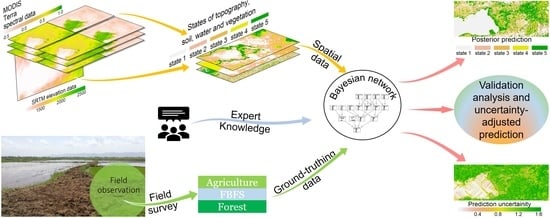Mapping Flood-Based Farming Systems with Bayesian Networks
Abstract
1. Introduction
- The diversity of FBFS settings: the diversity of FBFS settings in terms of floodwater availability, crop types, or social organization (e.g., spate irrigation in Tigray versus inundation canals in Kisumu) suggests that diagnostic elements aiming to operate at large scale should be framed into a conceptual model that can be applied in a wide range of contexts.
- The similarity of FBFS with other ecological systems: FBFS systems share characteristics with other ecological systems. They are similar to conventional irrigation in terms of supplementary irrigation, they resemble rainfed agriculture in terms of rainwater and growing period, and they share features with riparian vegetation in terms of extended growing period. These similarities indicate that valid concepts should be translated into flexible classification rules that can be used to highlight the most outstanding features of FBFS and discriminate them from the other ecological systems.
- The unpredictable nature of floods in FBFS: the large uncertainty in FBFS estimates, particularly in the areas these farming systems cover, implies the need for an approach that can detect agronomic flooding even in situations where flood events are not physically observable on satellite images. This is important because flood events may not leave a detectable trace of inundation, not only because the sensor can miss the flood event, but also because many FBFS have deep soils capable of storing large volumes of water. Agronomic flooding may also occur after the planting date, in which case it can be confused with other types of flood events because flood occurrence is largely unpredictable, and it is difficult to determine whether and how floods are used for FBFS purposes [3,4].
2. Materials and Methods
2.1. Study Area
2.2. Conceptual Framework
2.3. Acquisition of Nonspatial Data and Bayesian Network Specifications
2.4. Acquisition and Preprocessing of Spatial Data
2.5. Exploratory Analysis of the Normalized Difference Spectral Indices
2.6. Computation of Spatial Data Metrics
2.6.1. Slope and Flow Accumulation
2.6.2. Vegetation Sensitivity to Water Variation
2.6.3. Surface Sensitivity to Flooding
2.6.4. Soil Water Content
2.6.5. Surface Exposure to Wetness
2.6.6. Temporal Variation in Vegetation
2.6.7. Water Presence and Flood at the Beginning of the Rainy Season
2.6.8. Power of Tools
2.7. Computation of Spatial Data Nodes
2.7.1. Step 1: Computation of Boxplot Ranges and Presence/Absence Data
2.7.2. Step 2: Computation of Probabilities that Pixels Belong to a Boxplot Range Using Presence/Absence Data
2.7.3. Step 3: Identification of Most Likely Pixel States
2.7.4. Step 4: Deduction of State Values for Unclear Pixels
2.8. Expert System, Outputs, and Validation
3. Results
3.1. Spatiotemporal Analysis of Water and Vegetation
3.2. Prior Distributions of FBFS-Relevant Metrics
3.3. Posterior Distribution of FBFS-Relevant Metrics
3.4. Uncertainty of FBFS-Relevant Metrics
3.5. FBFS Potential in Kisumu County and Tigray
3.5.1. Spatial Coverage of FBFS and Prediction Uncertainty
3.5.2. Validation and Uncertainty-Adjusted Predictions
4. Discussion
- The extent and dynamics of environmental problems at various spatial scales: Environmental problems (e.g., pollution, flood disasters) are often predicted using multiple proxy metrics, each of which represents a potential source of uncertainty. While the approach can be used to derive such proxy variables from remotely sensed data, one of its main strengths is the ability to transparently track the sources of uncertainty. In most conventional assessments, evaluation and mapping of environment problems are generally achieved using multivariate techniques (e.g., weighted overlay), which do not allow assessing uncertainty in a spatially explicit manner.
- Cognitive tools: The single and multilayer procedures can be used to generate exploratory analyses of an area of interest, producing results that are useful as supporting materials in expert elicitation workshops, focus group discussions, or participatory mapping. The exploratory analysis can be illustrated by maps, based on which local experts can explain specific issues or estimate the probabilities of certain variables regarding the areas of interest. Such maps can also be provided to local communities to identify specific features of local systems as well as to validate predictions concerning their community.
- Project impact assessment: Development interventions, and projects in general, often require quantitative assessment of impact pathways and project-related risks [22,51]. The approach proposed in this paper can be used for framing and assessing the chances of project success or failure in a spatially explicit manner. The approach can also be useful in limiting the spatial scope of development interventions to areas where the risk of project failure is below a certain threshold.
- Spatial crop modelling: The approach we discussed in this paper can be used to estimate a wide range of important variables for crop production. These variables can then be used as inputs for probabilistic crop models [52] (under review) to estimate crop yield at various spatial scales. The approach can be easily modified for studying the state of crop yield in relation to qualitative model inputs, based on a multinomial Bayesian network describing pixel-scale yield potentials as discrete yield values. Studies aiming to assess continuous yield distributions are usually based on deterministic models operating at pixel level. In this regard, one could use mathematical equations to describe crop yield and integrate these equations into a continuous Bayesian network see [27]. Hybrid Bayesian networks see [27] provide an opportunity for extracting information from both quantitative and qualitative variables.
5. Conclusions
Supplementary Materials
Author Contributions
Funding
Acknowledgments
Conflicts of Interest
References
- Junk, W.; Bayley, P.; Sparks, R. The Flood Pulse Concept in River-Floodplain Systems. In Proceedings of the International Large River Symposium; Dodge, D.P., Ed.; Can. Spec. Publ: Honey Harbour, ON, Canada, 1989; pp. 110–127. [Google Scholar]
- Harlan, J.R.; Pasquereau, J. Décrue agriculture in Mali. Econ. Bot. 1969, 23, 70–74. [Google Scholar] [CrossRef]
- Haile, A.M. A Tradition in Transition, Water Management Reforms and Indigenous Spate Irrigation Systems in Eritrea, 1st ed.; CRC Press: London, UK, 2010. [Google Scholar]
- van Steenbergen, F.; Lawrence, P.; Mehari, A.; Salman, M.; Faurès, J.-M. Guidelines on Spate Irrigation; FAO: Rome, Italy, 2010. [Google Scholar]
- Varisco, D.M. Sayl and ghayl: The ecology of water allocation in Yemen. Hum. Ecol. 1983, 11, 365–383. [Google Scholar] [CrossRef]
- Liman, I.; Whitney, C.W.; Kungu, J.; Luedeling, E. Modelling Risk and Uncertainty in Flood-based Farming Systems in East Africa. In Tropentag Bonn “Future Agric. Socio-Ecological Transitions Bio-Cultural Shifts”; Academia: San Francisco, CA, USA, 2017; p. 289. [Google Scholar]
- Puertas, D.G.-L.; van Steenbergen, F.; Haile, A.M.; Kool, M.; Embaye, T.G. Flood Based Farming Systems in Africa; Overview paper; Flood-based Livelihood Network: Wageningen, The Netherlands, 2011; Available online: http://spate-irrigation.org/wp-content/uploads/2015/03/OP5_Flood-based-farming-in-Africa_SF.pdf (accessed on 31 October 2019).
- Gebremeskel, G.; Gebremicael, T.G.; Girmay, A. Economic and environmental rehabilitation through soil and water conservation, the case of Tigray in northern Ethiopia. J. Arid Environ. 2018, 151, 113–124. [Google Scholar] [CrossRef]
- FBLN. Flood-based Livelihood Network (FBLN) Foundation. Available online: http://spate-irrigation.org/ (accessed on 31 October 2018).
- Tucker, C.J. Red and photographic infrared linear combinations for monitoring vegetation. Remote Sens. Environ. 1979, 8, 127–150. [Google Scholar] [CrossRef]
- Hunt, E.R.; Rock, B.N. Detection of changes in leaf water content using Near- and Middle-Infrared reflectances. Remote Sens. Environ. 1989, 30, 43–54. [Google Scholar] [CrossRef]
- Gao, B. NDWI—A normalized difference water index for remote sensing of vegetation liquid water from space. Remote Sens. Environ. 1996, 58, 257–266. [Google Scholar] [CrossRef]
- McFeeters, S.K. The use of the Normalized Difference Water Index (NDWI) in the delineation of open water features. Int. J. Remote Sens. 1996, 17, 1425–1432. [Google Scholar] [CrossRef]
- Jenson, S.K.; Domingue, J.O. Extracting topographic structure from digital elevation data for geographic information system analysis. Photogramm. Eng. Remote Sens. 1988, 54, 1593–1600. [Google Scholar]
- Arge, L.; Chase, J.S.; Halpin, P.; Toma, L.; Vitter, J.S.; Urban, D.; Wickremesinghe, R. Efficient flow computation on massive grid terrain datasets. Geoinformatica 2003, 7, 283–313. [Google Scholar] [CrossRef]
- Ji, L.; Zhang, L.; Wylie, B. Analysis of Dynamic Thresholds for the Normalized Difference Water Index. Photogramm. Eng. Remote Sens. 2009, 75, 1307–1317. [Google Scholar] [CrossRef]
- Boschetti, M.; Nutini, F.; Manfron, G.; Brivio, P.A.; Nelson, A. Comparative Analysis of Normalised Difference Spectral Indices Derived from MODIS for Detecting Surface Water in Flooded Rice Cropping Systems. PLoS ONE 2014, 9, e88741. [Google Scholar] [CrossRef] [PubMed]
- Kuhnert, P.M.; Martin, T.G.; Mengersen, K.; Possingham, H.P. Assessing the impacts of grazing levels on bird density in woodland habitat: A Bayesian approach using expert opinion. Environmetrics 2005, 16, 717–747. [Google Scholar] [CrossRef]
- Kuhnert, P.M.; Martin, T.G.; Griffiths, S.P. A guide to eliciting and using expert knowledge in Bayesian ecological models. Ecol. Lett. 2010, 13, 900–914. [Google Scholar] [CrossRef] [PubMed]
- Hubbard, D.W. How to Measure Anything: Finding the Value of Intangibles in Business, 3rd ed.; John Wiley & Sons, Inc.: Hoboken, NJ, USA, 2014. [Google Scholar]
- Whitney, C.; Shepherd, K.; Luedeling, E. Decision Analysis Methods Guide; Agricultural Policy for Nutrition; World Agroforestry Centre: Nairobi, Kenya, 2018; Available online: http://dx.doi.org/10.5716/WP18001.PDF (accessed on 31 October 2019).
- Yet, B.; Constantinou, A.; Fenton, N.; Neil, M.; Luedeling, E.; Shepherd, K. A Bayesian Network Framework for Project Cost, Benefit and Risk Analysis with an Agricultural Development Case Study. Expert Syst. Appl. 2016, 60, 141–155. [Google Scholar] [CrossRef]
- Whitney, C.; Lanzanova, D.; Muchiri, C.; Shepherd, K.D.; Rosenstock, T.S.; Krawinkel, M.; Tabuti, J.R.S.; Luedeling, E. Probabilistic Decision Tools for Determining Impacts of Agricultural Development Policy on Household Nutrition. Earth’s Future 2018, 6, 359–372. [Google Scholar] [CrossRef]
- Kisumu County Government. Kisumu County First Integrated Development Plan 2013–2017; Kisumu County Government: Kenya Vision 2030: Kisumu, Kenya, 2013. [Google Scholar]
- Pourret, O.; Naïm, P.; Marcot, B. Bayesian Networks: A Practical Guide to Applications, 1st ed.; John Wiley & Sons Ltd.: Chichester, UK, 2008. [Google Scholar]
- Pearl, J. Causality: Models, Reasoning and Inference; Cambridge University Press: Cambridge, UK, 2000; ISBN 0521773628. [Google Scholar]
- Scutari, M.; Denis, J.-B. Networks Bayesian with Examples in R, 1st ed.; Dominici, F., Faraway, J.J., Tanner, M., Zidek, J., Eds.; CRC Press: Boca Raton, FL, USA, 2015. [Google Scholar]
- R Core Team. R: A Language and Environment for Statistical Computing; R Foundation for Statistical Computing: Vienna, Austria, 2018. [Google Scholar]
- Jsgaard, S.H. Graphical Independence Networks with the gRain Package for R. J. Stat. Softw. 2012, 46, 1–26. [Google Scholar] [CrossRef]
- Jarvis, A.; Reuter, H.I.I.; Nelson, A.; Guevara, E. Hole-Filled Seamless SRTM Data V4. Available online: http://srtm.csi.cgiar.org (accessed on 31 October 2019).
- Farr, T.G.; Rosen, P.A.; Caro, E.; Crippen, R.; Duren, R.; Hensley, S.; Kobrick, M.; Paller, M.; Rodriguez, E.; Roth, L.; et al. The Shuttle Radar Topography Mission. Rev. Geophys. 2007, 45, RG2004. [Google Scholar] [CrossRef]
- King, M.D.; Herring, D.D.; Diner, D.J. The Earth Observing System: A Space-based Program for Assessing Mankind’s Impact on the Global Environment. Opt. Photonics News 1995, 6, 34. [Google Scholar] [CrossRef]
- GADM Database of Global Administrative Areas. Available online: https://gadm.org/index.html (accessed on 18 May 2018).
- Hijmans, R.J. Raster: Geographic Data Analysis and Modeling, R package version 2.8-19; The Comprehensive R Archive Network; 2019. Available online: https://cran.r-project.org/web/packages/raster/index.html (accessed on 20 August 2020).
- CGIAR-CSI SRTM 90m Digital Elevation Database v4.1. Available online: http://srtm.csi.cgiar.org/ (accessed on 20 January 2020).
- Vermote, E. MOD09A1 MODIS/Terra Surface Reflectance 8-Day L3 Global 500m SIN Grid V006. Available online: https://lpdaac.usgs.gov/products/mod09a1v006/ (accessed on 31 October 2019).
- Mattiuzzi, M.; Detsch, F. MODIS: Acquisition and Processing of MODIS Products, R package version 1.1.6; The Comprehensive R Archive Network; 2018. Available online: https://cran.r-project.org/web/packages/MODIS/index.html (accessed on 20 August 2020).
- Busetto, L.; Ranghetti, L. MODIStsp: An R package for automatic preprocessing of MODIS Land Products time series. Comput. Geosci. 2016, 97, 40–48. [Google Scholar] [CrossRef]
- Luedeling, E. chillR: Statistical Methods for Phenology Analysis in Temperate Fruit Trees, R package version 0.70.21; The Comprehensive R Archive Network; 2019. Available online: https://cran.r-project.org/web/packages/chillR/index.html (accessed on 20 August 2020).
- Leutner, B.; Horning, N.; Schwalb-Willmann, J. RStoolbox: Tools for Remote Sensing Data Analysis. The Comprehensive R Archive Network. 2019. Available online: https://cran.r-project.org/web/packages/RStoolbox/index.html (accessed on 20 August 2020).
- Revelle, W. Psych: Procedures for Psychological, Psychometric, and Personality Research, R package version 1.9.12; The Comprehensive R Archive Network; 2019. Available online: http://personality-project.org/r (accessed on 20 August 2020).
- Tarboton, D.G.; Bras, R.L.; Rodriguez-Iturbe, I. On the extraction of channel networks from digital elevation data. Hydrol. Process. 1991, 5, 81–100. [Google Scholar] [CrossRef]
- Tarboton, D.G. A new method for the determination of flow directions and upslope areas in grid digital elevation models. Water Resour. Res. 1997, 33, 309–319. [Google Scholar] [CrossRef]
- Tesfa, T.K.; Tarboton, D.G.; Watson, D.W.; Schreuders, K.A.T.; Baker, M.E.; Wallace, R.M. Extraction of hydrological proximity measures from DEMs using parallel processing. Environ. Model. Softw. 2011, 26, 1696–1709. [Google Scholar] [CrossRef]
- Yu, H.; Xu, J.; Okuto, E.; Luedeling, E. Seasonal Response of Grasslands to Climate Change on the Tibetan Plateau. PLoS ONE 2012, 7, e49230. [Google Scholar] [CrossRef] [PubMed]
- White, M.A.; Thornton, P.E.; Running, S.W. A continental phenology model for monitoring vegetation responses to interannual climatic variability. Glob. Biogeochem. Cycles 1997, 11, 217–234. [Google Scholar] [CrossRef]
- Nychka, D.; Furrer, R.; Paige, J.; Sain, S. fields: Tools for Spatial Data, R package version 10.0; University Corporation for Atmospheric Research: Boulder, CO, USA, 2017. [Google Scholar]
- Roy, D.; Borak, J.S.; Devadiga, S.; Wolfe, R.E.; Zheng, M.; Descloitres, J. The MODIS Land product quality assessment approach. Remote Sens. Environ. 2002, 83, 62–76. [Google Scholar] [CrossRef]
- Hothorn, T.; Hornik, K.; Zeileis, A. Unbiased Recursive Partitioning: A Conditional Inference Framework. J. Comput. Graph. Stat. 2006, 15, 651–674. [Google Scholar] [CrossRef]
- Masante, D. Bnspatial: Spatial Implementation of Bayesian Networks and Mapping, R package version 1.1; The Comprehensive R Archive Network; 2019. Available online: https://cran.r-project.org/web/packages/bnspatial/index.html (accessed on 20 August 2020).
- Luedeling, E.; Oord, A.L.; Kiteme, B.; Ogalleh, S.; Malesu, M.; Shepherd, K.D.; De Leeuw, J. Fresh groundwater for Wajir-ex-ante assessment of uncertain benefits for multiple stakeholders in a water supply project in Northern Kenya. Front. Environ. Sci. 2015, 3. [Google Scholar] [CrossRef]
- Liman Harou, I.; Whitney, C.; Kungu, J.; Luedeling, E. Modelling Risk and Uncertainty in Flood-Based Farming Systems Using a Knowledge-Based Approach; Academia: San Francisco, CA, USA, 2017. [Google Scholar]
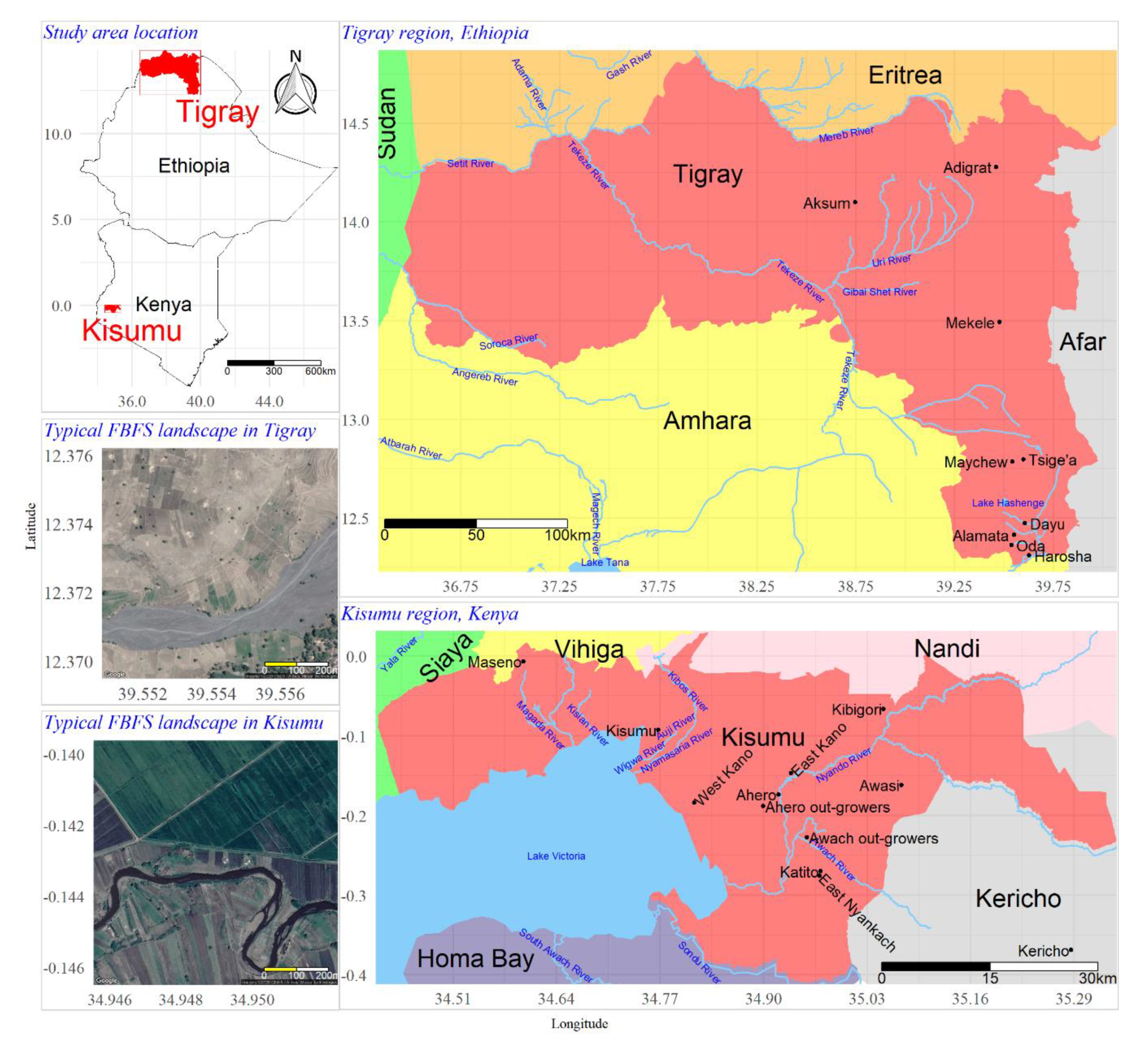

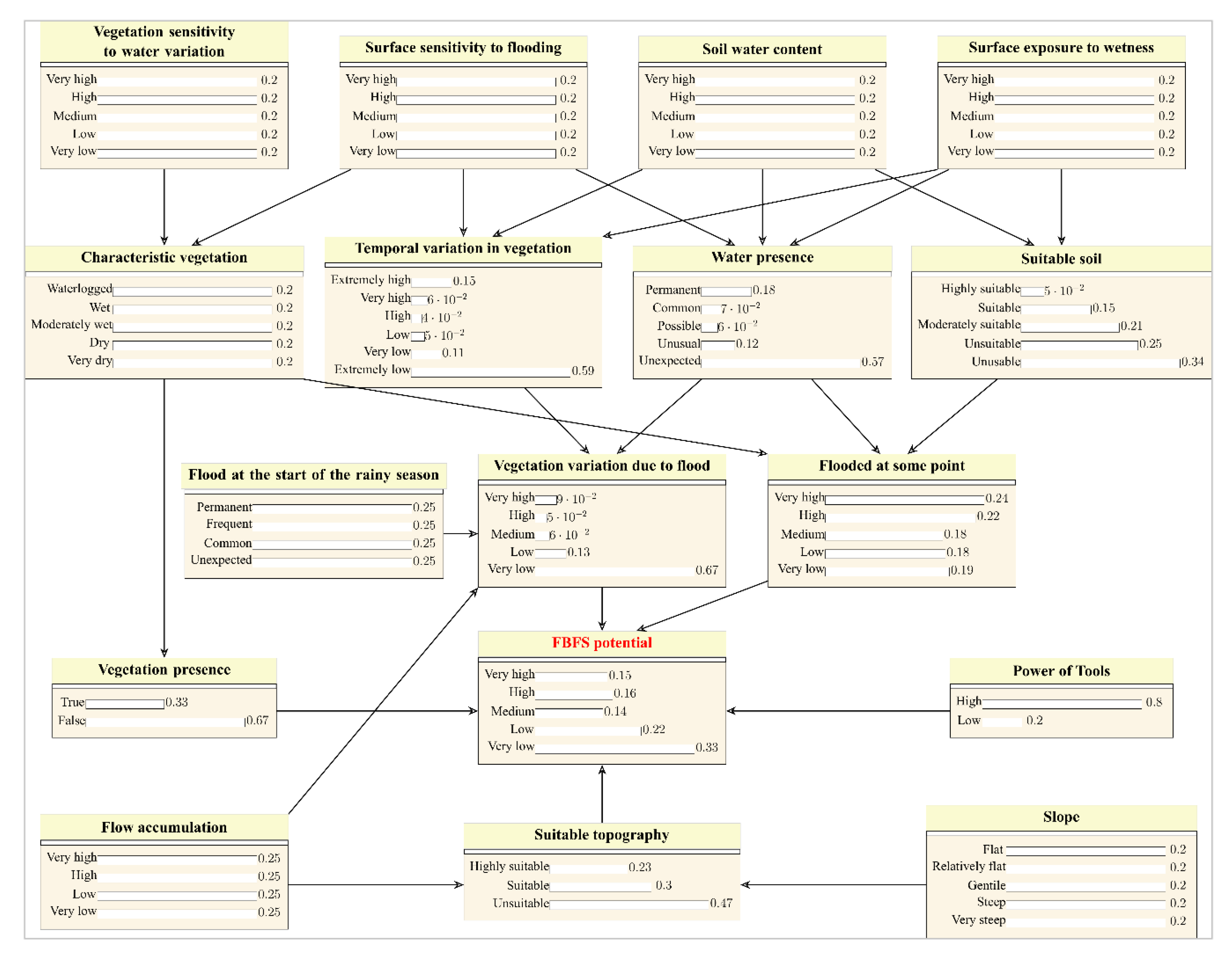

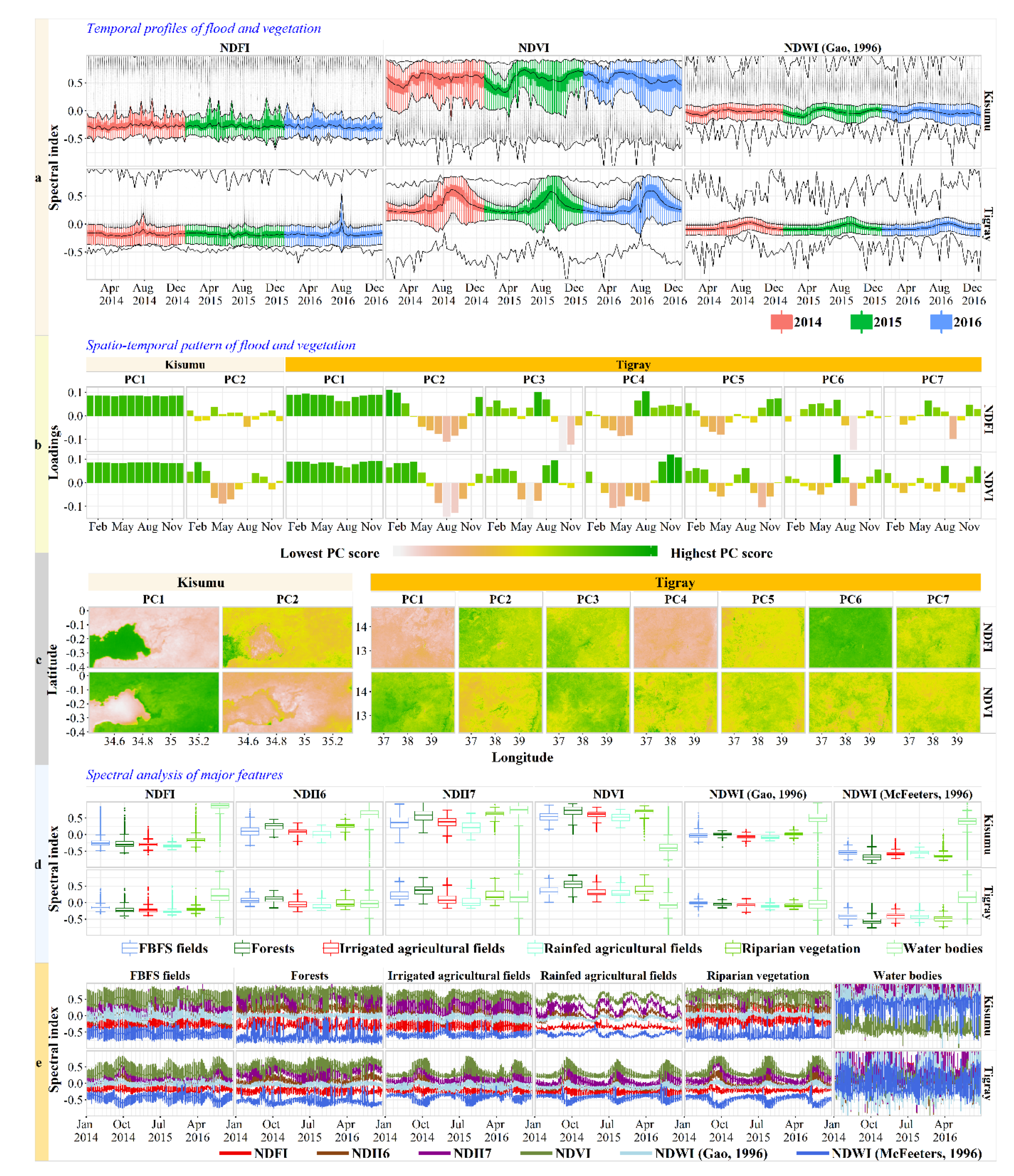

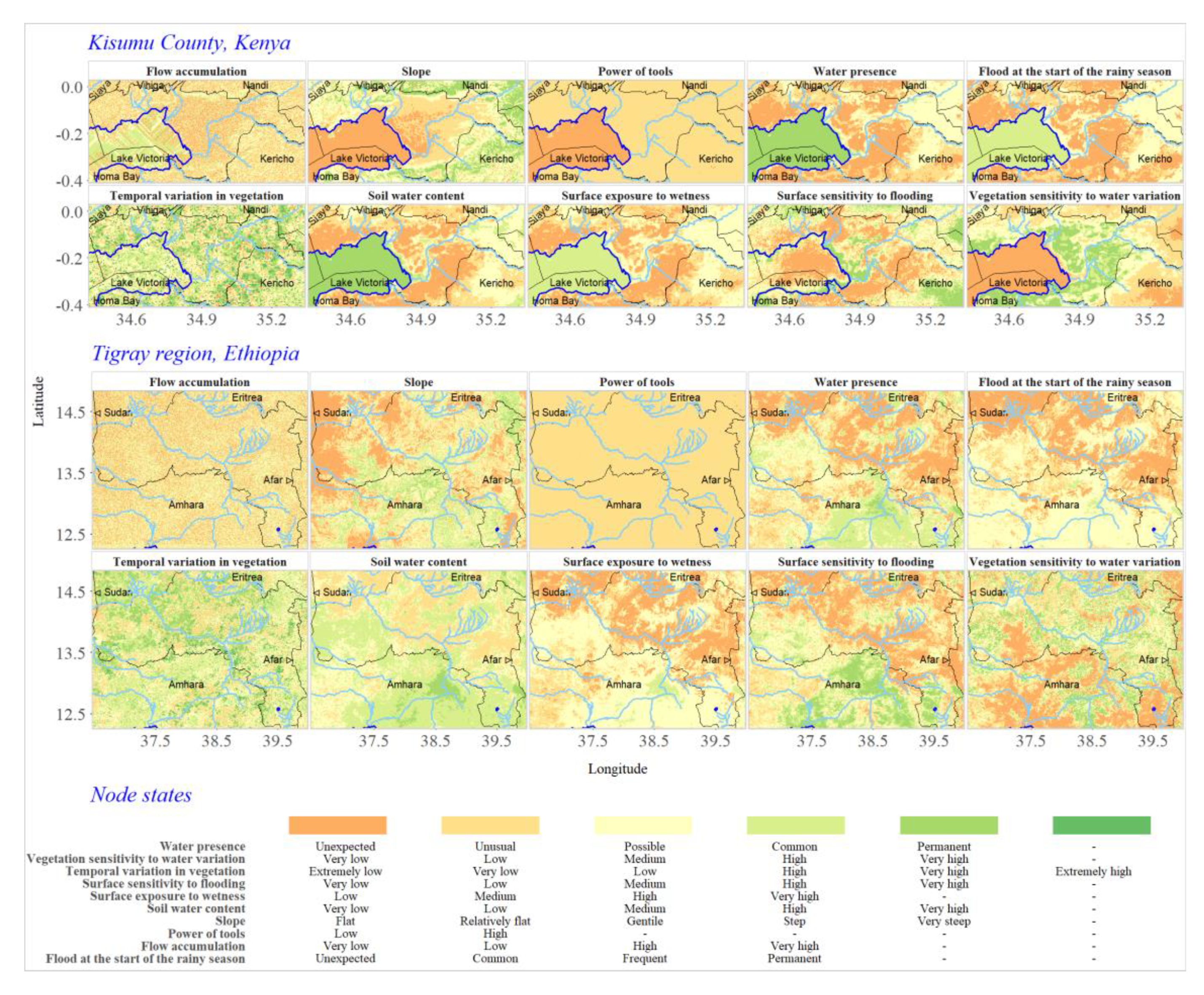
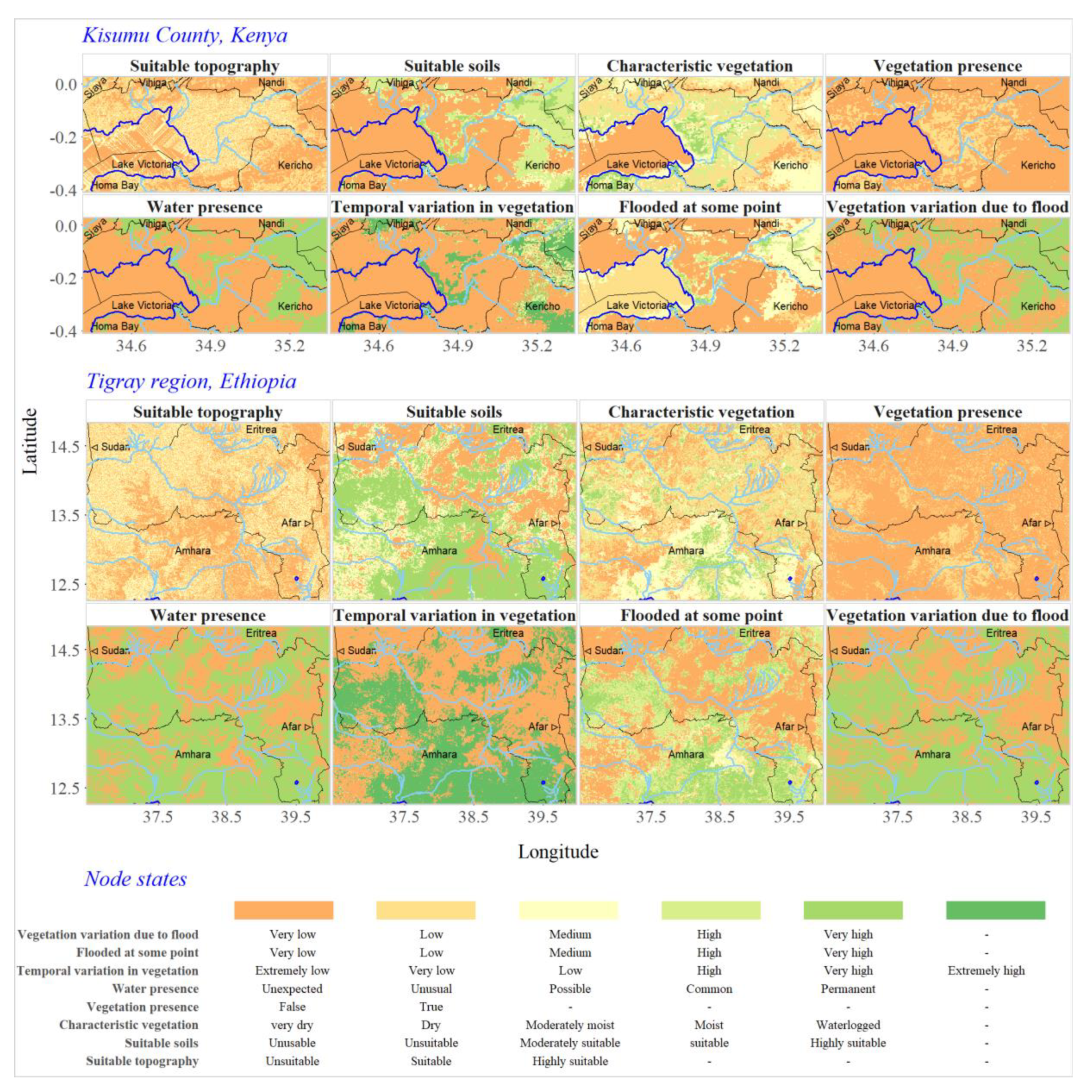
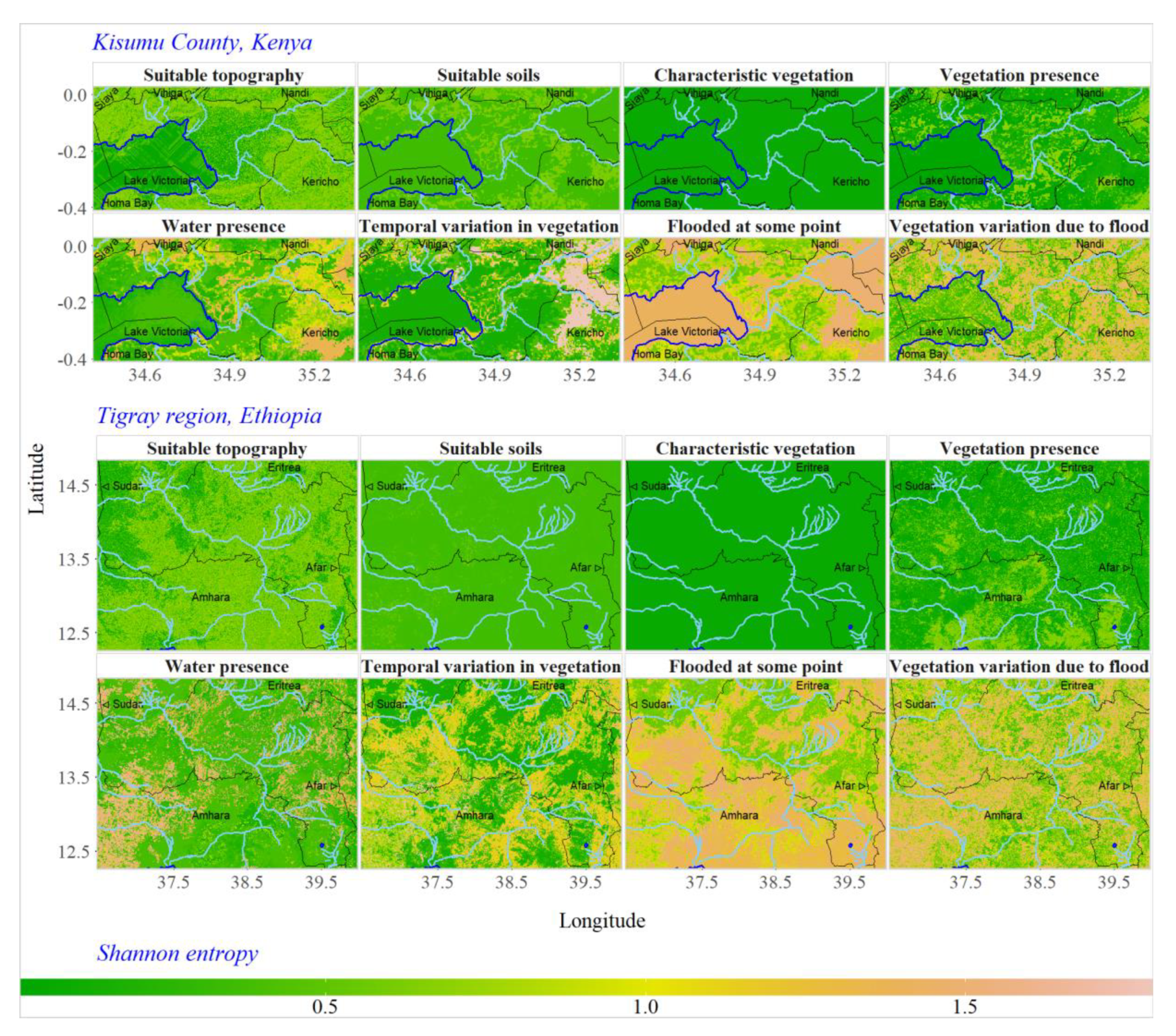
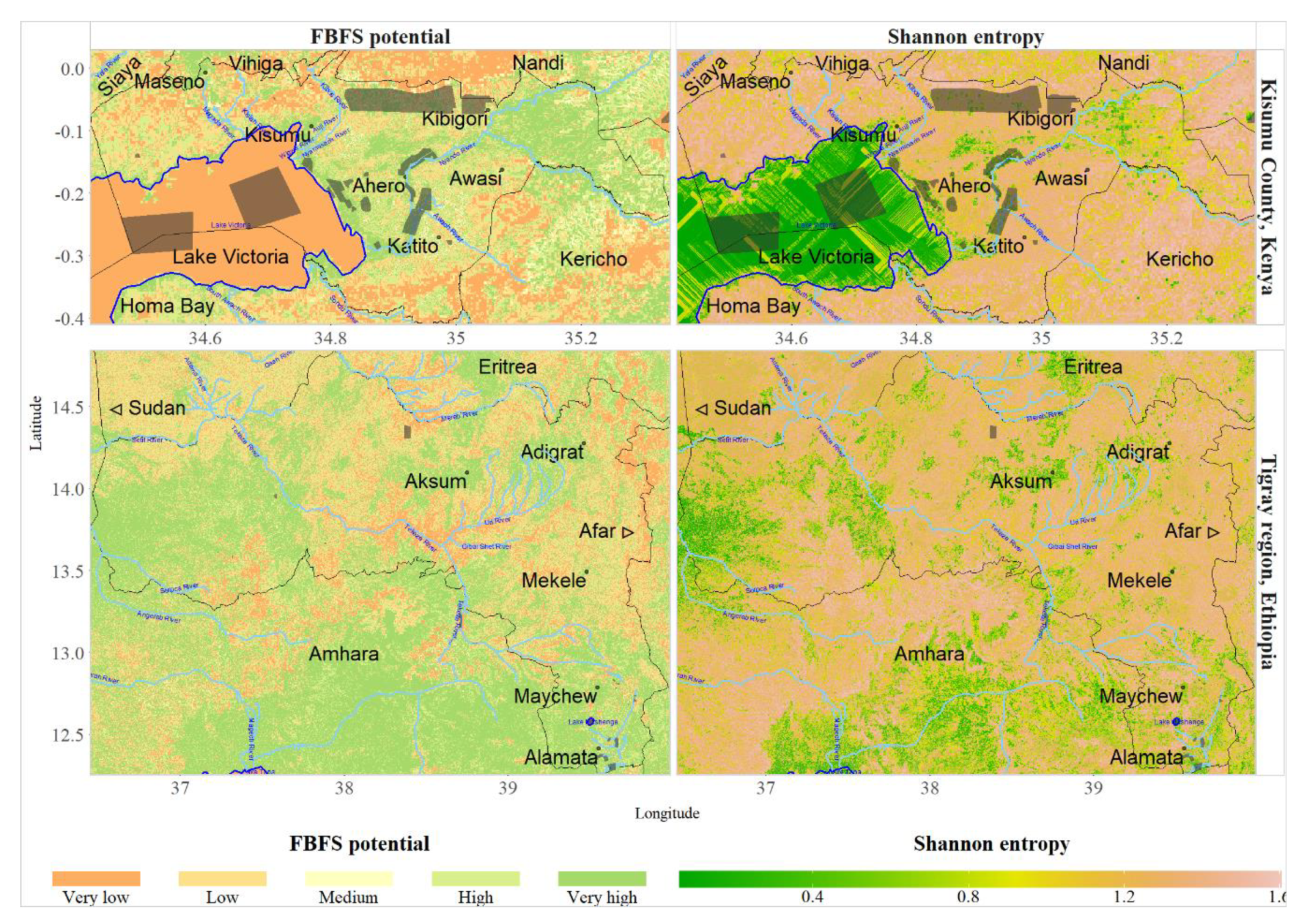
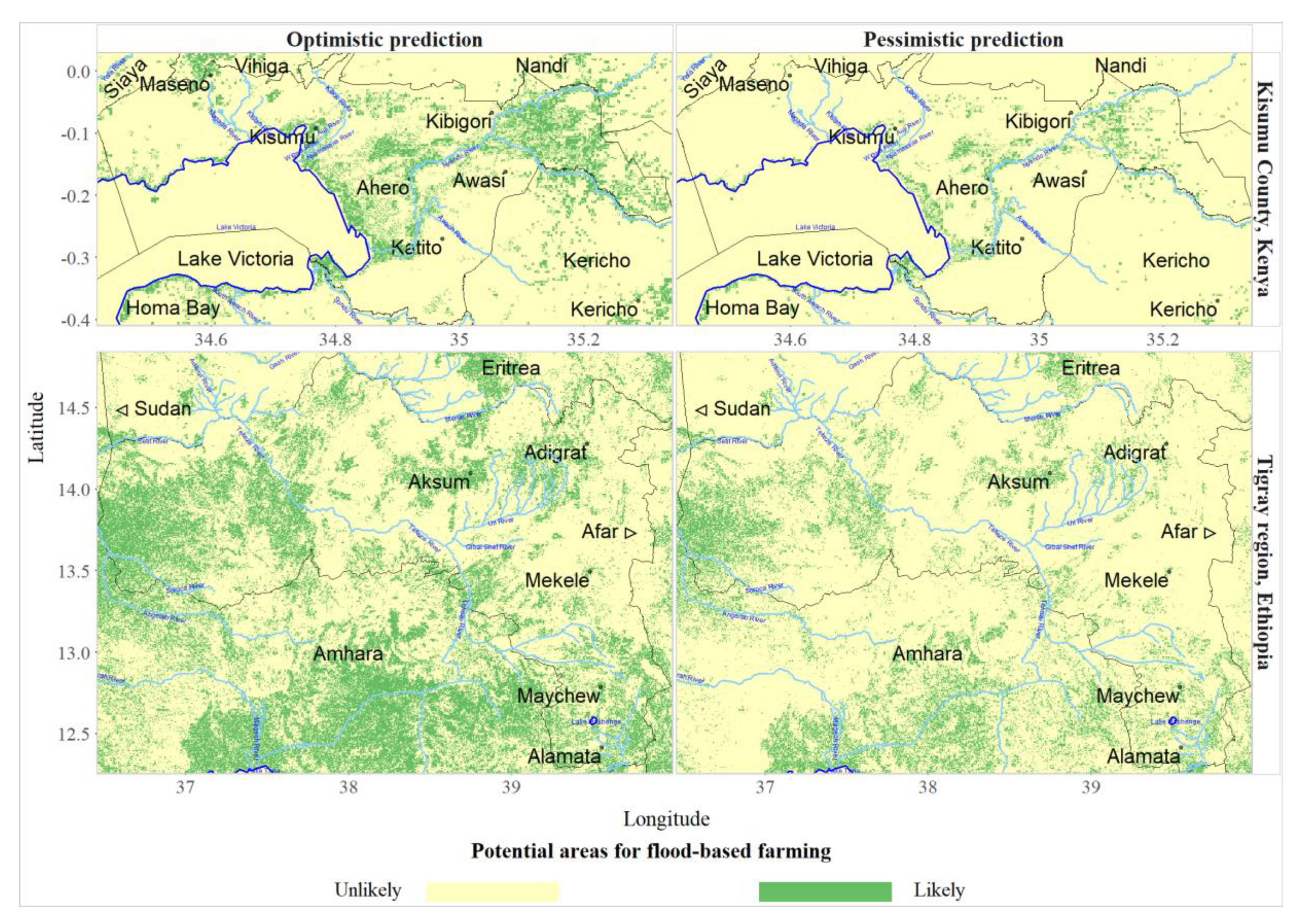
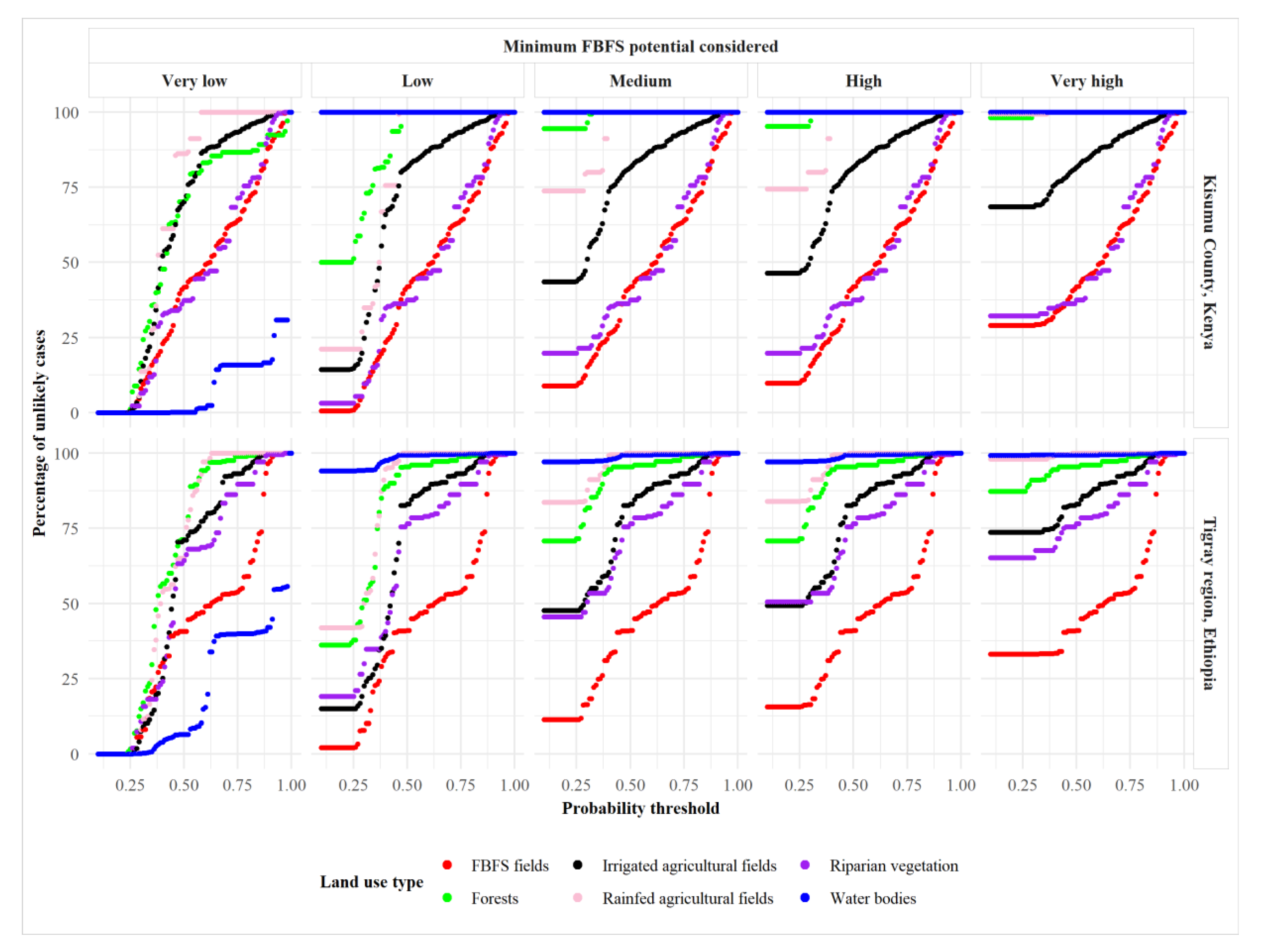
| Spectral Index | MODIS Bands | MODIS Spectral Range | Full Name |
|---|---|---|---|
| NDVI | B2, B1 | (NIR2 − VISRed)/(NIR + VISRed) | Normalized Difference Vegetation Index [10] |
| NDFI | B1, B6 | (NIR1 − SWIR1)/(NIR + SWIR1) | Normalized Difference Flood Index [17] |
| NDII6 | B2, B6 | (NIR2 − SWIR1)/(NIR2 + SWIR1) | Normalized Difference Infrared Index—Band 6 [11] |
| NDII7 | B2, B7 | (NIR2 − SWIR2)/(NIR2 + SWIR2) | Normalized Difference Infrared Index—Band 7 [11] |
| Gao NDWI | B2, B5 | (NIR2 − NIR5)/(NIR2 + NIR5) | Normalized Difference Water Index (NDWI) [12] |
| McFeeters NDWI | B4, B2 | (VISgreen − NIR2)/(VISgreen + NIR2) | Normalized Difference Water Index (NDWI) [13] |
| 2-Bit Encoded per Pixel QA Code | Decimal Value | Quality Attribute Meaning |
|---|---|---|
| 00 | 0 | Pixel produced, good quality, not necessary to examine more detailed QA |
| 01 | 1 | Pixel produced, unreliable or unquantifiable quality, recommend examination of more detailed QA |
| 10 | 2 | Pixel not produced due to cloud effects |
| 11 | 3 | Pixel not produced primarily due to reasons other than cloud |
| Study Area | Validation Polygons | |||
|---|---|---|---|---|
| Land Use Type | Description | Number | Area (km2) | |
| Kisumu | FBFS fields | Water is mainly acquired via gravity from rivers or lakes | 11 | 48.9 |
| Forests | More than 60% tree cover | 5 | 7.3 | |
| Irrigated agricultural fields | Water is mainly acquired using pumps | 2 | 92.0 | |
| Rainfed agricultural fields | Water mainly acquired via rainfall | 2 | 1.3 | |
| Riparian vegetation | Vegetation close to water | 4 | 6.7 | |
| Water bodies | Areas permanently covered by water | 2 | 164.9 | |
| Tigray | FBFS fields | Water is mainly acquired via gravity from dry wadis | 9 | 65.7 |
| Forests | More than 60% tree cover | 4 | 3.3 | |
| Irrigated agricultural fields | Water is mainly acquired using pumps and wells | 4 | 9.9 | |
| Rainfed agricultural fields | Water mainly acquired via rainfall | 2 | 38.0 | |
| Riparian vegetation | Vegetation close to water | 4 | 1.6 | |
| Water bodies | Areas permanently covered by water | 5 | 33.2 | |
| Study Area | Area Covered by the Respective FBFS Potential Class (km2 and Share of Total Area) | ||||
|---|---|---|---|---|---|
| Very Low | Low | Medium | High | Very High | |
| Kisumu County, Kenya | 873.3 (32.8%) | 552.7 (20.7%) | 72.5 (2.7%) | 495.5 (18.6%) | 670.8 (25.2%) |
| Tigray region, Ethiopia | 9000.9 (17.1%) | 11,185.2 (21.3%) | 597.0 (1.1%) | 11,530.2 (21.9%) | 20,209.3 (38.5%) |
| Study Area | Validation Polygons | FBFS Potential | ||||||
| Land use type | Number | Area (km2) | Very low | Low | Medium | High | Very high | |
| Kisumu | FBFS fields | 11 | 48.9 | 0.6% | 8.4% | 0.9% | 19.2% | 70.9% |
| Forests | 5 | 7.3 | 50.0% | 44.6% | 0.6% | 2.8% | 1.9% | |
| Irrigated agricultural fields | 2 | 92.0 | 14.4% | 29.1% | 2.9% | 22.1% | 31.5% | |
| Rainfed agricultural fields | 2 | 1.3 | 21.3% | 52.5% | 0.6% | 25.0% | 0.6% | |
| Riparian vegetation | 4 | 6.7 | 3.2% | 16.5% | 0.0% | 12.4% | 67.8% | |
| Water bodies | 2 | 164.9 | 100.0% | 0.0% | 0.0% | 0.0% | 0.0% | |
| Tigray | FBFS fields | 9 | 65.7 | 2.1% | 9.2% | 4.3% | 17.5% | 66.8% |
| Forests | 4 | 3.3 | 36.1% | 34.7% | 0.0% | 16.5% | 12.7% | |
| Irrigated agricultural fields | 4 | 9.9 | 15.0% | 32.7% | 1.7% | 24.3% | 26.3% | |
| Rainfed agricultural fields | 2 | 38.0 | 41.9% | 41.7% | 0.4% | 14.0% | 2.0% | |
| Riparian vegetation | 4 | 1.6 | 19.1% | 26.5% | 4.9% | 14.7% | 34.8% | |
| Water bodies | 5 | 33.2 | 94.0% | 3.1% | 0.0% | 2.2% | 0.7% | |
© 2020 by the authors. Licensee MDPI, Basel, Switzerland. This article is an open access article distributed under the terms and conditions of the Creative Commons Attribution (CC BY) license (http://creativecommons.org/licenses/by/4.0/).
Share and Cite
Liman Harou, I.; Whitney, C.; Kung’u, J.; Luedeling, E. Mapping Flood-Based Farming Systems with Bayesian Networks. Land 2020, 9, 369. https://doi.org/10.3390/land9100369
Liman Harou I, Whitney C, Kung’u J, Luedeling E. Mapping Flood-Based Farming Systems with Bayesian Networks. Land. 2020; 9(10):369. https://doi.org/10.3390/land9100369
Chicago/Turabian StyleLiman Harou, Issoufou, Cory Whitney, James Kung’u, and Eike Luedeling. 2020. "Mapping Flood-Based Farming Systems with Bayesian Networks" Land 9, no. 10: 369. https://doi.org/10.3390/land9100369
APA StyleLiman Harou, I., Whitney, C., Kung’u, J., & Luedeling, E. (2020). Mapping Flood-Based Farming Systems with Bayesian Networks. Land, 9(10), 369. https://doi.org/10.3390/land9100369





